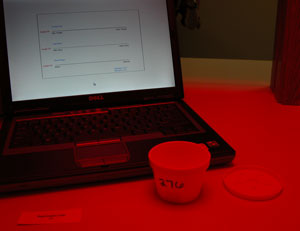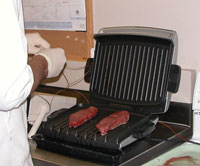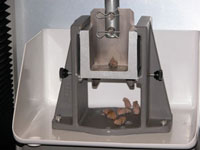 Individual booths, red lights to mask colors, positive pressure ventilation to keep out unwanted smells and pass-through sample presentation doors – that’s the environment where trained sensory panelists do their work at the ISU Sensory Evaluation Unit.
Individual booths, red lights to mask colors, positive pressure ventilation to keep out unwanted smells and pass-through sample presentation doors – that’s the environment where trained sensory panelists do their work at the ISU Sensory Evaluation Unit.
So, basically this is what you see, sitting in your little booth, waiting for samples to come through the little door. You cleanse your palate with crackers and water and get to work evaluating the samples one at a time with just numbers to identify them. You tell the computer what you think and move on to the next. Not bad work for a college student, especially if they are hungry!
 Elanco Animal Health is particularly interested in how any product they might bring to market for livestock might impact the meat than comes from the animal. That’s why the ag editors who attended the Elanco Sensory Evaluation Briefing at ISU this week were trained specifically on the attributes of interest to their study – tenderness, juiciness and flavor of a very plain piece of steak. Of course, our results were for demonstration purposes only – but they said we did pretty well compared to the more objective Warner-Bratzler shear determination of meat tenderness. Problem was, we got three samples and two of them were deliberately tough – only one was tender. Not as good as the steaks we had for dinner the night before, that’s for sure!
Elanco Animal Health is particularly interested in how any product they might bring to market for livestock might impact the meat than comes from the animal. That’s why the ag editors who attended the Elanco Sensory Evaluation Briefing at ISU this week were trained specifically on the attributes of interest to their study – tenderness, juiciness and flavor of a very plain piece of steak. Of course, our results were for demonstration purposes only – but they said we did pretty well compared to the more objective Warner-Bratzler shear determination of meat tenderness. Problem was, we got three samples and two of them were deliberately tough – only one was tender. Not as good as the steaks we had for dinner the night before, that’s for sure!
 We also got to go “backstage” to the prep area and see how they prepare the samples – on George Foreman grills to heat both sides at the same time to the exact desired temperature. Pretty nifty. Then we got to see how they cored meat samples and checked them for tenderness with the shear method. All very interesting. Real sensory panelists don’t get to see behind the scenes, so we felt very special!
We also got to go “backstage” to the prep area and see how they prepare the samples – on George Foreman grills to heat both sides at the same time to the exact desired temperature. Pretty nifty. Then we got to see how they cored meat samples and checked them for tenderness with the shear method. All very interesting. Real sensory panelists don’t get to see behind the scenes, so we felt very special!

